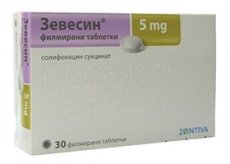Medical expert of the article
New publications
Preparations
Zevesin
Last reviewed: 03.07.2025

All iLive content is medically reviewed or fact checked to ensure as much factual accuracy as possible.
We have strict sourcing guidelines and only link to reputable media sites, academic research institutions and, whenever possible, medically peer reviewed studies. Note that the numbers in parentheses ([1], [2], etc.) are clickable links to these studies.
If you feel that any of our content is inaccurate, out-of-date, or otherwise questionable, please select it and press Ctrl + Enter.

The drug Zevesin belongs to the pharmacological group of urological agents. Manufacturer - Zentiva (Czech Republic). Names of synonymous drugs: Solifenacin, Vesikar; analogues include: Urotol (Detruzitol), Driptan (Dream-Apo, Sibutin, Novitropan) and Spazmex.
Release form
Zevesin: film-coated tablets of 5 and 10 mg.
Pharmacodynamics
The pharmacological action of the drug Zevesin is provided by the active substance - the tertiary amine solifenacin succinate, which is a specific blocker (inhibitor) of m-cholinergic receptors.
Solifenacin affects the endings of parasympathetic nerve fibers - muscarinic acetylcholine receptors of the ejection muscle of the bladder wall (detrusor), as a result of which the increased tone of the smooth muscles of the bladder decreases to physiological. Thus, the therapeutic effect of the drug Zevesin is to restore normal neuromuscular functioning of the bladder and stop involuntary urination.
Pharmacokinetics
After oral administration, Zevesin is absorbed in the gastrointestinal tract and enters the systemic bloodstream. The bioavailability of solifenacin succinate is almost 90%.
It binds to blood plasma proteins (almost 98%), the maximum plasma concentration of the active substance is observed 3-8 hours after application.
85% of Zevesin undergoes biotransformation by the liver isoenzyme CYP3A4. One of the metabolites (4R-hydroxy-solifenacin) is active, which contributes to a longer therapeutic effect of the drug.
The active substance is excreted from the body through the kidneys (69%) and intestines. The half-life is 45-68 hours.
Use marshmallow during pregnancy
Due to the lack of sufficient clinical studies, use during pregnancy and lactation also requires caution.
Contraindications
Contraindications to the use of Zevesin include: hypersensitivity to solifenacin, urinary tract obstruction, chronic gastrointestinal tract pathologies, colon hypertrophy (megacolon), weakness of striated muscles (myasthenia), severe renal and/or hepatic failure, closed-angle glaucoma, hemodialysis, childhood, congenital galactose intolerance, glucose-galactose malabsorption, as well as treatment with active inhibitors of cytochrome CYP3A4.
In patients with gastrointestinal obstruction and low motility, hiatal hernia, gastroesophageal reflux, prolonged QT syndrome and low blood potassium levels (hypokalemia), Zevesin should be administered with great caution.
Side effects marshmallow
Zevesin may cause side effects that most often manifest as: dry mouth, nasal passages and mucous membranes of the eyes, constipation, accommodation disorders, urinary retention, urticaria, angioedema, liver dysfunction, increased drowsiness, confusion and the occurrence of hallucinations.
It is also possible that nausea and vomiting, swelling in the legs, pain in the stomach, etc. may occur.
Overdose
Overdose of this drug causes more intense manifestation of its side effects. In such cases, it is necessary to use activated carbon, gastric lavage and symptomatic treatment.
Interactions with other drugs
The drug Zevesin, interaction with other drugs blocking m-cholinergic receptors, increases the likelihood of unwanted side effects.
The simultaneous use of antifungal agents that block liver enzymes – Miconazole, Ketoconazole, Itraconazole and other triazole derivatives – contributes to an increase in the concentration of Zevesin in blood plasma.
Zevesin reduces the therapeutic effect of antiemetic drugs used in gastroenterology (Metoclopramide hydrochloride, Cerucal, Regastrol), as well as Peristil (Cisapride) used in the treatment of intestinal dyskinesia.
In order to avoid creating an increased risk of complications, Zevesin should not be prescribed together with drugs from the group of selective calcium channel inhibitors (Verapamil, Veracard, etc.).
Storage conditions
Store Zevesin: at a temperature not exceeding +25°C.
Shelf life
Shelf life: 36 months.
 [ 24 ]
[ 24 ]
Attention!
To simplify the perception of information, this instruction for use of the drug "Zevesin" translated and presented in a special form on the basis of the official instructions for medical use of the drug. Before use read the annotation that came directly to medicines.
Description provided for informational purposes and is not a guide to self-healing. The need for this drug, the purpose of the treatment regimen, methods and dose of the drug is determined solely by the attending physician. Self-medication is dangerous for your health.

